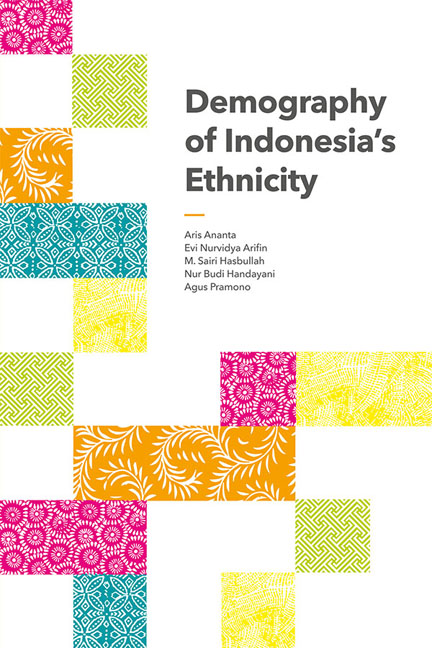Book contents
- Frontmatter
- Contents
- List of Tables
- List of Figures
- Foreword
- Acknowledgements
- 1 CHANGING INDONESIA: An Introduction
- 2 COMPLEXITY OF STATISTICS ON ETHNICITY: Concept, Data and Method of Analysis
- 3 THE NEW CLASSIFICATION: Uncovering Diversity
- 4 ETHNIC DIVERSITY: New Demographic Evidence
- 5 THE FIFTEEN LARGEST ETHNIC GROUPS: Age-Sex Structure and Geographical Distribution
- 6 CHANGE IN SIZE AND COMPOSITION OF ETHNIC GROUPS: Indonesia, 2000–2010
- 7 RELIGION AND LANGUAGE: Two Important Ethnic Markers
- References
- Appendix 1
- Appendix 2
- Index
- About the Authors
2 - COMPLEXITY OF STATISTICS ON ETHNICITY: Concept, Data and Method of Analysis
Published online by Cambridge University Press: 10 October 2017
- Frontmatter
- Contents
- List of Tables
- List of Figures
- Foreword
- Acknowledgements
- 1 CHANGING INDONESIA: An Introduction
- 2 COMPLEXITY OF STATISTICS ON ETHNICITY: Concept, Data and Method of Analysis
- 3 THE NEW CLASSIFICATION: Uncovering Diversity
- 4 ETHNIC DIVERSITY: New Demographic Evidence
- 5 THE FIFTEEN LARGEST ETHNIC GROUPS: Age-Sex Structure and Geographical Distribution
- 6 CHANGE IN SIZE AND COMPOSITION OF ETHNIC GROUPS: Indonesia, 2000–2010
- 7 RELIGION AND LANGUAGE: Two Important Ethnic Markers
- References
- Appendix 1
- Appendix 2
- Index
- About the Authors
Summary
CONCEPT OF ETHNICITY
As elaborated by Baumann (2004), it is not easy to define ethnicity. It is a much debated topic, though best defined in cultural anthropology. There is no consensus on how to define ethnicity and how ethnic groups are created. This chapter does not aim to elaborate on the debate. Rather, it focuses on the concept used in the demographic analysis on Indonesia's ethnicity, the theme of this book.
Ethnicity is not “culture”. It is related to a particular kind of identity, imposed or otherwise. It is a result of self and group identity that is created within extrinsic and intrinsic contexts as well as social interaction.
Ethnicity is generally defined as a sense of group belonging, with the core characteristics of common origin, history, culture, language, experience and values (Baumann 2004; Radcliffe 2010). Bulmer (1996) defined an ethnic group as follows:
An ethnic group is a collectivity within a larger population having real or putative common ancestry, memories of a shared past and a cultural focus upon one or more symbolic elements which define the group's identity, such as kinship, religion, language, shared territory, nationality or physical appearance. Members of an ethnic group are conscious of belonging to the group.
Ethnicity is different from race. Racial stratification is related to birthascribed status based on physical and cultural characteristics imposed by outsiders. A person cannot change his/her race. On the other hand, although also ascribed at birth, ethnic groups usually can define their own cultural characteristics themselves.
Ethnic identity may be dynamic, not static over time, and dependent upon context, as people inhabit a more complex world in which they interact with more than one ethnic group. An ethnicity of a person is voluntary, meaning that an individual may change his/her ethnic identity if s/he feels that s/he is closer to his/her new ethnic group. Through intermarriage, cultural exchange, political change, migration and assimilation, some individuals may change their ethnic identities and affiliation (Baumann 2004; Radcliffe 2010).
People may change their identities because of political reasons. An example is a Chinese person who was born and grew up in a Javanese community. He does not speak any Chinese, but speaks Javanese fluently. During the Soeharto New Order era, he hid his Chinese identity and identified himself as a Javanese person.
- Type
- Chapter
- Information
- Demography of Indonesia's Ethnicity , pp. 16 - 38Publisher: ISEAS–Yusof Ishak InstitutePrint publication year: 2014

